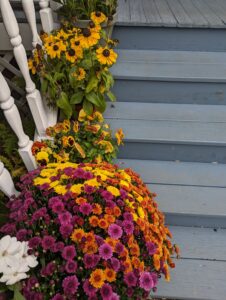 The great day of autumn reckoning in my garden is almost at hand. The New England asters, which have provided a magnificent, impressionistic spectacle in the front beds, are holding tenaciously to their last blooms. Over the coming weekend I will cut back all the tall stalks, leaving only the ‘Monch’ asters to continue billowing out over the beds. I will also cut back all the Joe Pye-weed, which finished blooming weeks ago, but has made a nice contrast with the asters.
The great day of autumn reckoning in my garden is almost at hand. The New England asters, which have provided a magnificent, impressionistic spectacle in the front beds, are holding tenaciously to their last blooms. Over the coming weekend I will cut back all the tall stalks, leaving only the ‘Monch’ asters to continue billowing out over the beds. I will also cut back all the Joe Pye-weed, which finished blooming weeks ago, but has made a nice contrast with the asters.
The feeling I get after this great winnowing, is somewhat akin to the malaise I feel after I put away the holiday decorations in January. The garden seems sad and deflated. Usually the winnowing coincides with the departure of the butterflies, but this year there are still a few wafting around. Yesterday I looked out my front window and saw a single monarch drinking nectar in the still-blooming butterfly bush, along with a handful of cabbage butterflies taking advantage of the last of the aster flowers.
Gardeners are inherently hopeful, so I know that the winnowing will also give me a chance to take better stock of whatever remains in the garden, not to mention thinking about additions that I can make to provide later season color next year.
And while I am contemplating additions, I can do a bit of necessary subtraction, removing the weeds that have flourished in the protective shade provided by the tall asters. I can continue my ultimately futile efforts to eradicate the onion grass that spent the summer hiding underground, only to emerge with a vengeance in the beds and lawn about ten days ago. I can weed ruthlessly until the spaces between the short remnants of the aster stalks looks bare instead of weedy. And then, if strength and inspiration have not deserted me, I will spread the mulch that has been sitting in my holding area for the last six weeks.
Spring starts with diminutive plants like snowdrops, aconite and snow crocuses. In fall, small is beautiful once again, with the appearance of the autumn-blooming crocuses and colchicums. I especially like Crocus sativus, the saffron crocus, with its purple to periwinkle-colored petals and bright red-orange stamens. If you had enough of those crocuses, you could harvest the stamens and use them to flavor food. I need a few hundred more just to brighten up the edges of the beds.
I will also plan to acquire more colchicums, which bloom at the same time as the fall crocuses. I have a few Colchicum autumnale ‘Alboplenum’, which look like white water lilies. Next year I hope to augment those with the purple-pink ‘Waterlily’ variety. The bulbs are a bit expensive, but even a single one makes a visual splash.
Garden mums are fall stars, and the few in my beds stand out. My favorite is ‘Clara Curtis’, an old-fashioned pink-flowered variety with narrow single petals and bright yellow centers. When ‘Clara’ is happy, the plant produces lots of branched stems laden with flowers. I forgot to give them the “Chelsea chop” in May, so ‘Clara’ is a bit leggy. I rectified the situation by staking the floppy stems and now it looks both perkier and more abundant. Next year, I will add a few more ‘Clara Curtis’ plants, plus a couple of ‘Mary Stoker’ chrysanthemums, another older variety. ‘Mary’ features the same daisy flowers as ‘Clara’, but the petals are yellow, developing a slight pink tint as they age.
I can even order my ‘Clara’ and ‘Mary’ plants now for spring delivery, which will ensure that I will have plenty of blooms a year from now.
A handful of garden shrubs are still hard at work producing flowers. My fuchsia-flowered rugosa rose has gotten so much water during the rainy late summer season that it has grown exponentially and pumped out a few fragrant blossoms. However the rugosa’s real attraction at this time of year is the crop of hips, which are bright orange-red and look like small cherry tomatoes. The pale purple butterfly bush is still attracting pollinators, as is its yellow-flowered sibling. The latter is always the last to emerge in the spring, but compensates by being productive until hard frosts set in. On the south side of my house, the standard peegee hydrangea—Hydrangea paniculata ‘Grandiflora’–is laden with big, fat flowerheads, now making the transition from greenish-pink to autumnal beige. A small rhododendron in the back has ignored my neglect of its wellbeing and produced a nice crop of lavish pink and white blooms.
The still-blooming plants will not compensate for the seasonal demise of the asters, but they do provide welcome spots of brightness. I will add to those with a few pansies in rich fall tones of amber, russet and dark purple. As in other years, the bald spots will find themselves covered with potted “hardy” mums, which are inexpensive and plentiful, but generally fail to live up to the “hardy” designation.
And of course, variable fall weather always brings its share of surprises. In years past I have sometimes harvested a handful of garden roses to include in the Thanksgiving centerpiece. Their presence outside and inside is heartening, especially during the perennial Thanksgiving Day struggle to finish both bulb planting and turkey basting.
